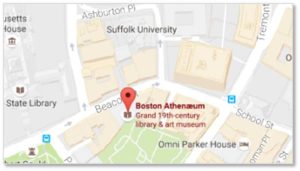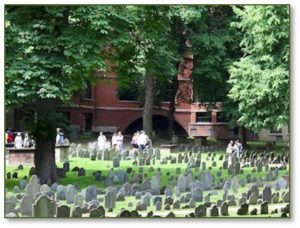This is the 24th post in the series on Boston’s Hidden Gems.
I thought the Boston Athenaeum was all private all the time but I was wrong. For years I walked past its building on Beacon Street just east of the State House without thinking of going in. How could I when I wasn’t a member of this private library? That would have been like walking into the Harvard Club when I graduated from Northeastern. It simply isn’t done.
Then I heard the first floor was open to the public and I put the Boston Athenaeum on my list of places to visit.
Note: Athenaeums are membership libraries devoted to research and the promotion of learning. Named for Athena, the Greek goddess of wisdom, they once were numerous in the U.S. but there are fewer than a dozen.
Origin of the Athenaeum
Fourteen members of the Anthology Society founded the Boston Athenaeum in 1807. These gentlemen created a public library that would include the great works of learning and science. The institution defines its mission as follows:
The mission of the Boston Athenæum is to serve its members, the broader community, and scholars throughout the world by preserving and augmenting its collections of books and art, by providing library services and cultural programs, and by preserving and enhancing the unique atmosphere of its landmark building.
Both the library and the art gallery, which the Athenaeum established in 1827, grew rapidly by purchases and donation. They continue to do so today and approximately 3,000 books join the collection each year. The Boston Athenaeum’s front windows look out on Beacon Street and its sunny back windows overlook the Old Granary Burying Ground.
For nearly 50 years, the Athenæum formed the center of intellectual life in Boston, and by 1851 it had become one of the five largest libraries in America. Today its collections comprise over half a million volumes and it is one of the oldest independent libraries in the United States.
The Fifth Location
As with many of Boston’s institutions, the Athenaeum occupied multiple locations around the city before settling in its current Beacon Street location. This structure, designed by Edward Clarke Cabot, opened in 1849 as the Athenaeum’s fifth address.
The Athenaeum’s directors selected Mr. Cabot’s design, although he was not an architect at the time, because he employed an ingenious arch over graves in the Old Granary Burying Ground that provides more floor space above the basement level.
The Boston Athenaeum’s neo-Palladian façade constructed of “Patterson sandstone” was unique in Boston and remains so today. The original building was only three stories tall when it opened, however. A renovation designed by Henry Forbes Bigelow in 1913 and 1914 added the fourth and fifth floors, setting them back so as not to ruin the façade’s symmetry. The building received a designation as a National Historic Landmark in 1966.
The First Floor
I visited the Athenaeum on a hot summer morning and walking into its cool quiet interior felt like stepping into a pool of water. I pushed through the red doors, put my bag into one of the lockers inside the main entrance, picked up a sticker from the receptionist, and stepped back in time.
The first floor provides a beautiful combination of books, paintings and sculpture. As I had limited time, I skipped the special exhibition of prints and photographs and simply cruised around, taking in as much as I could. I could access most of the floor but a few rooms and offices are marked Private for Members Only.
The first floor houses only a fraction of the Athenaeum’s collection of over 600,000 books and, I assume, of its art collection as well. But what I could see impressed me. In particular, the works of Bradley Phillips (1929 – 1991) knocked me out with their virtuoso use of pastels, a difficult medium.
In just this small space I saw numerous works of nineteenth and twentieth century art, including a John Singer Sargent portrait of George McCulloch, three works by Bradley Phillips, a portrait bust in marble by Daniel Chester French, several monumental sculptures, and a portrait of The Reverend Doctor Thaddeus Mason Harris by Chester Harding.
Why is the Rev. Dr. Harris interesting? Take Boston By Foot’s special tour in October and you’ll find out. He’s one of two reasons the Athenaeum is the first stop on next month’s Murder, Martyrs and Mysticism tour.
Guided Tours
Now that I know what marvelous works this collection includes, I have to make a point of taking one of the Athenaeum’s guided tours so I can see even more. The library holds art and architecture tours that are open to the public on Tuesdays and Thursdays at 3:00 p.m.., Sundays at 1:00 p.m. and Mondays at 5:30 p.m. The tours last an hour and cover the architectural history of the building as well as the art collection.
If you want to take a tour, make a reservation (required) at 617-227-0270 ext. 221. The Athenaeum recommends booking a space a month in advance, particularly for Sunday tours.
Directions and Information
The Boston Athenaeum
10 ½ Beacon Street
Boston, MA 02108
 You can find information on library hours and tour schedules on the Take a Tour page at the Athenaeum’s website. Directions, maps and information on parking are on the Plan Your Visit page.
You can find information on library hours and tour schedules on the Take a Tour page at the Athenaeum’s website. Directions, maps and information on parking are on the Plan Your Visit page.
Boston’s Hidden Gems
With 24 posts on Boston’s Hidden Gems, listing them all takes up too much room. You can find the list on The Next Phase Blog’s Posts About Boston page, along with all the other posts I have written about the city.






Great write ups on these places and I am going to have to make a point to explore some of them. One comment or perhaps question. Since I am an amateur photography enthusiasts so I bring my camera with me on these things with the intent of doing of a lot of photography. Certainly this isn’t a problem with places like observation decks. But what about places like Boston Athenaeum where their might be some restrictions on photography of some of their artwork and other displays? So I thought I would suggest adding a section to each of these write ups if you noted anything about photography being allowed or restricted in some way.
Thanks!
Good point, Patrick. I did take pictures in the Athenaeum and no one said boo. I just use an iPhone, though so it’s pretty unobtrusive. I don’t know how they would react to someone with a big camera. I often take pictures off the Internet because they’re better than anything I could capture.